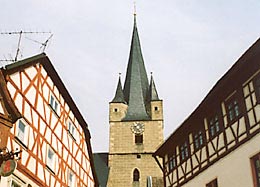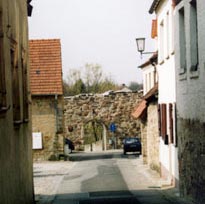|
|
 |
 |
 |
|
 Zeil am Main Zeil am Main
City by the Roadside |
|
Since the 11th century the territories of the dioceses Wuerzburg and Bamberg overlapped in the River Main valley. Here their claims to power collided.
The River Main and an ancient trade route and military road were the lifelines of the region and the basic reasons for a settlement there. |
|
 |
|
|
|
|
|
That arterial road connected the free city of Schweinfurt and the free city of Nuernberg as well as it connected the cathedral city of Wuerzburg with the cathedral city of Bamberg. Mixed farming, fruit-growing and viticulture and the versatile handling of Main sandstone were the assumptions for the inhabitants to earn their living.
In 1379 bishop Lamprecht of Prun granted municipal law to the citizens and the city of Zeil. As result of the construction of the city wall with numerous towers and the building of Schmachtenberg castle, which replaced ancient "castrum cilanum” up on chapel’s hill, the city received a well-fortified character and made the claim to power of the collegiate monastery of Bamberg obvious. The prince bishops of Bamberg really succeeded in sustaining Zeil’s position as the northern enclave versus Wuerzburg. During numerous military conflicts generations of troops passed that ancient military road. Zeil had become the bone of contention of noblemen and sovereigns. |
|
|
|
|
|

|
|
|
|
Local History of Zeil am Main |
|
600-800 AD: settlement by the Thuringians, who finally were overlaid by Franconian immigrants.
1018: Zeil is first proved by documents in a deed of donation, signed by Emperor Heinrich II.
In 1379 the bishop of Bamberg Lamprecht of Prun granted to the citizens of Zeil the right to build a fortification to protect the city.
1397: Zeil received market law by King Wenzel of Bohemia.
In 1695 the prince bishop’s hunting lodge was built.
 |
|







